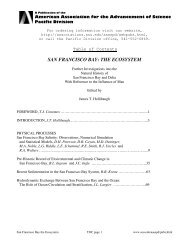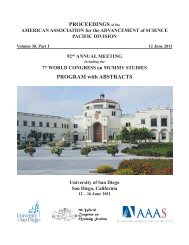Vol 31, Part I - forums.sou.edu ⢠Index page - Southern Oregon ...
Vol 31, Part I - forums.sou.edu ⢠Index page - Southern Oregon ...
Vol 31, Part I - forums.sou.edu ⢠Index page - Southern Oregon ...
Create successful ePaper yourself
Turn your PDF publications into a flip-book with our unique Google optimized e-Paper software.
ABSTRACTS – Symposia<br />
years. Soils were collected from directly beneath plants and<br />
from plant-interspaces, after which they were fractionated<br />
into macroaggregates, free microaggregates and free silt and<br />
clay fractions. Further, macroaggregates were separated into<br />
particulate organic matter (POM), microaggregates and silt<br />
and clay fractions. We measured the relative abundance of<br />
soil fractions, and SOC within the fractions. Results showed<br />
that increased precipitation decreased SOC in all treatments,<br />
but not in soils underneath sagebrush, where SOC incorporation<br />
into more stable soil fractions was enhanced. Our data<br />
suggest that precipitation in semi arid ecosystems deplete<br />
SOC contents, and that plant species mediate the impact of<br />
precipitation on soil C dynamics.<br />
38 Influence of Precipitation Regime on Microbial Decomposition<br />
Patterns and Community Structure in Semi-Arid<br />
Ecosystems: Altered Roles of Bacteria and Fungi, KEVIN<br />
FERIS 1 *, CARRIE JILEK 1 , DAVID HUBER 2 , KEITH<br />
REINHARDT 2 , MARIE-ANNE de GRAAFF 1 , KATH-<br />
ERINE LOHSE 2 , and MATT GERMINO 3 ( 1 Department<br />
of Biological Sciences, Boise State University, 1910 University<br />
Dr. Boise, ID 83725; 2 Department of Biological Science,<br />
Idaho State University, Pocatello, ID; 3 USGS FRESC, Boise<br />
ID, 83725; kevinferis@boisestate.<strong>edu</strong>).<br />
In water-limited semi-arid sagebrush steppe ecosystems<br />
changes in climate may manifest as a shift from historically<br />
winter/snow-dominated precipitation regimes to<br />
one dominated by spring rains. In these ecosystems soil<br />
microorganisms play a vital role in linking the effects of<br />
water availability and plant productivity to biogeochemical<br />
cycling. Patterns of soil microbial catalyzed organic matter<br />
decomposition patterns (i.e. patterns of extracellular enzyme<br />
activity (EEA)) and soil community structure may respond<br />
both directly and indirectly to climate-induced changes in<br />
precipitation regime. For example, EEA patterns are thought<br />
to depend upon the quantity and quality of soil organic matter<br />
(SOM), pH, and mean annual precipitation. However,<br />
sagebrush-steppe plant communities respond strongly to<br />
changes in the timing and magnitude of precipitation, and<br />
preliminary findings by our group suggest that corresponding<br />
changes in SOM quantity, quality, N-cycle dynamics,<br />
and soil structure are occurring. Other groups have demonstrated<br />
shifts from a bacterial to fungal dominated community<br />
as precipitation regime shifts from winter to summer<br />
precipitation. We hypothesized: 1) Shifts in the timing and<br />
magnitude of precipitation indirectly affect soil microbial<br />
decomposition patterns via responses in the plant community<br />
structure and subsequent effects on soil organic matter<br />
quantity/quality; and 2) Changes in precipitation patterns<br />
may both directly and indirectly affect soil community structure,<br />
potentially uncoupling interactions between plant and<br />
soil community structure. We tested these hypotheses in a<br />
long-term (> 15 year) precipitation manipulation experiment<br />
in the sagebrush-steppe. Results are presented in the context<br />
of biotic responses to climate and subsequent alterations in<br />
C and N cycling.<br />
39 Effects of Climate Shifts and Plant-Community Transformations<br />
on Carbon and Nitrogen Cycling in Semi-Arid<br />
Rangelands, DAVID P HUBER 1 *, KATHERINE LOHSE 1 ,<br />
MATT HERMINO 2 , KEITH REINHARDT 1 , KEVIN<br />
FERIS 3 , and MARIE-ANNE de GRAAFF 3 ( 1 Department<br />
of Biological Science, Idaho State University, Pocatello, ID,<br />
83207; 2 USGS FRESC, Boise ID, 83725; 3 Department of<br />
Biological Sciences, Boise State University, 1910 University<br />
Dr. Boise, ID 83725; hubedavi@isu.<strong>edu</strong>).<br />
Semi-arid rangelands are being impacted by climate<br />
shifts and plant-community transformations. However, little<br />
is known about how these ecosystems will respond to longterm<br />
changes in climate or how shifts in vegetation will modulate<br />
ecosystem processes. We used an established long-term<br />
ecohydrologic experiment (Est. 1993) in <strong>sou</strong>theastern Idaho<br />
to evaluate ecosystem response to altered precipitation patterns<br />
and changing plant communities (sagebrush vs. Crested<br />
Wheatgrass (CWG)). We also assessed how response patterns<br />
varied due to landscape heterogeneity (i.e. inter-plant<br />
vs. under-plant patches and shallow vs. deep soils).<br />
Preliminary results show increased precipitation altered<br />
available N pools, with NH 4<br />
+<br />
increasing and NO 3<br />
-<br />
decreasing<br />
relative to controls. Surprisingly, vegetation dynamics,<br />
not precipitation patterns controlled overall N pools and<br />
processes. Sagebrush systems have greater NO 3<br />
-<br />
pools than<br />
CWG, which reflects the high rates of N mineralization and<br />
nitrification under sagebrush vs. high rates of N immobilization<br />
under CWG. These patterns may make sagebrush systems<br />
more vulnerable to invasive plant species and nutrient<br />
losses.<br />
Inter-plant patches responded to precipitation treatments<br />
more strongly than under-plant soils, showing increased<br />
nutrient pools and process rates and r<strong>edu</strong>cing landscape<br />
re<strong>sou</strong>rce heterogeneity. Deep soils had greater carbon pools<br />
and available N than shallow soils. Shallow soils showed differential<br />
control on C and N pools for sagebrush vs. CWG<br />
systems, exaggerating N transformation rates for sagebrush<br />
but muting rates for CWG.<br />
Overall, these results suggest that plant community<br />
dynamics and landscape heterogeneity may play a larger role<br />
in dictating ecosystem response to future changes in climate<br />
than expected previously.<br />
40 Identifying Holocene Relationships among Climate, Vegetation,<br />
Fire and Fire-related Erosion using Alluvial Charcoal<br />
and Fossilized Woodrat (Neotoma) Middens at City of<br />
Rocks National Reserve, Idaho, KERRIE WEPPNER 1 *,<br />
JEN PIERCE 1 , and JULIO BETANCOURT 2 ( 1 Department<br />
of Geosciences, Boise State University, 1910 University<br />
Dr. Boise, ID 83725; 2 USGS NRP, 1955 E 6th St., Tucson,<br />
AZ 85719; kwepp@yahoo.com).<br />
58








